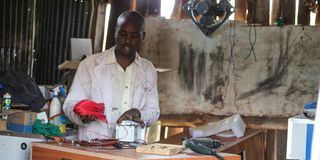My home-made incubator makes egg hatching easier

Robert Kipkoech in the process of making an incubator in his workshop in Kericho County. He has come up with a chicken incubator that is proving popular among farmers.
What you need to know:
- The incubator dubbed Robsafarm has a control panel that displays the temperature and humidity, an air conditioner, heater, an exhaust fan and a motor used to turn the eggs in the machine.
- Dr Ludovicus Okitoi, the Kenya Agricultural and Livestock Research Organisation (Kalro), Kakamega centre director, says there are many factors that contribute to non-hatching of eggs.
- He sells the 176 eggs machine at Sh45, 000, 352 at Sh60,000, 528 at Sh70,000 and 1,056 at Sh108,000. Each of them has a one-year warranty.
- Dr Okitoi advises farmers seeking to buy incubators to ensure that its control panel is stable enough to maintain the temperature and humidity in the chamber.
Kiptegan village in Kericho County is a quiet settlement, characterised by huge tea farms, with the cash crop being the mainstay of the region.
Robert Kipkoech, 32, is one of the residents of Kiptegan. The 32-year-old, however, unlike the rest, is keen on poultry farming.
Kipkoech, who holds a diploma in electronics from the Rift Valley Institute of Technology (RVIT), has come up with a chicken incubator that is proving popular among farmers.
“My incubators are electric and of 176, 352, 528 and 1,056 eggs capacities. Among these, the most popular is the 352-egg capacity machine,” he says.
The incubator dubbed Robsafarm has a control panel that displays the temperature and humidity, an air conditioner, heater, an exhaust fan and a motor used to turn the eggs in the machine.
In the lower compartment that holds the trays, there is a rectangular metallic container. A heater is fastened to it from the inside, to heat the water placed in there to maintain the correct humidity.
“I have made them in such a way that they retain heat for a long time. Even when there’s no power, the heat inside takes between 10-12 hours,” says Kipkoech, who also repairs faulty gadgets for farmers in the venture he started in 2012.
The first incubator he made was a 1,056 capacity machine and he still keeps it to date. “I have sold 120 gadgets of various capacities to customers in Kericho, Nyamira, Vihiga and Kakamega since I started.”
Working well
Joseph Kirui, a farmer from Chebot location, Ainamoi, Kericho County, who uses one of the incubators, says it is working well. “I have a 352-egg capacity, which I use to hatch eggs. The hatch rate has been about 86 per cent, which is good,” he says, adding bad eggs and faulty gadgets are among contributors of low hatch rates.
Kipkoech offers a one-year warranty for his products. “If there’s a mechanical problem, I assess and fixes it. Most of the time you will find it is the fan or the motor that develop problems,” he says.
Dr Ludovicus Okitoi, the Kenya Agricultural and Livestock Research Organisation (Kalro), Kakamega centre director, says there are many factors that contribute to non-hatching of eggs.
“You are supposed to hatch eggs that are not older than 10 days. Anything above 10 days will not hatch. It would have a dead embryo by then.”
Another factor is that an egg’s airspace encased at one of the tips within the shell might have been affected by an unfavourable environment that the egg was subjected to.
“If the chick grows in an environment that is not desired for that age, this airspace will not supply adequate oxygen to the embryo. So the embryo will die,” explains the scientist.
Some farmers, he says, wash or dip eggs in water. “Never do that and never use oily hands. This is because the shell has some pores that might be closed or clogged, therefore, depriving the embryo of oxygen.”
To make the 352-egg capacity incubator, Kipkoech says he needs Sh35,000. “I import some of the key components of the incubators, which makes the cost high but it is still lower than the factory-made gadgets.”
He sells the 176 eggs machine at Sh45, 000, 352 at Sh60,000, 528 at Sh70,000 and 1,056 at Sh108,000. "Each of them has a one-year warranty,” he says.
Well-ventilated house
Kipkoech, who acquired some of his knowledge on installation of control panels and wiring of the gadgets, in Qatar when he went in 2012, employs four casuals at his workshop. Wiring is his forte. Others take care of welding, housing and carpentry.
He explains that his machine needs moderate temperature but not below -100C. So in areas which experience high temperatures, a double exhaust fan has to be added to the gadget.
“The machine also needs to be placed in a well-ventilated house. For cold areas, one exhaust fan would be sufficient. The size of the ventilators may be reduced. This would minimise heat loss from the machine.”
Most of the farmers he has sold the gadgets are supported by the Kenya Climate Smart Agriculture Project (KCSAP).
“The organisation chose my incubators after most farmers preferred them,” says Kipkocech, who markets the gadgets at farmers’ forums .
Dr Okitoi advises farmers seeking to buy incubators to ensure that its control panel is stable enough to maintain the temperature and humidity in the chamber.
He recommends reducing the frequency of opening and closing of the incubator as much as possible.
“Most farmers lose their eggs at this most critical stage. The incubation period is day one up to day 18 with a set temperature of 380C and a humidity of 60 per cent. If you maintain the correct temperature and humidity and your eggs are fertile, you’ll be able to maintain a very high production percentage.”




